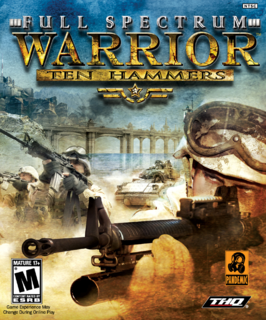Full Spectrum Warrior: Ten Hammers improves many of the problems with the first game, but not all of them
The first game was a pure tactical bound and manuever strategy war game; the player did not do any shooting, instead the game issued commands to the different squads of American soldiers and watched them perform the actions.
Created as a training device for the US Army, Full Spectrum Warrior taught it's players how to move through an urban environment populated with enemies who could show up at any time, and so learning to move and use cover was essential.
The first game was not easy, and some of the levels were downright hard as the slightest mistake left you watching your squad writhering on the ground in their death throes as the game screen slowly changed to a sepia-toned 'game over' look.
There are many improvements in this sequel:
1. Team movement is much more coordinated and can be done faster
2. Teams can be split up, each 4 man squad splitting into units of 2, meaning the gamer can have 4 different units to move around the battlefield.
3. Now the player is given a Bradly Armored Vehicle to play with, and can call in mortar and air strikes more often than in the first game.
4. Also, the gamer can now focus in and guide a particular soldiers shooting as they take on the terrorists, meaning it's not all strategic manuevering.
The addition of vehicles to control and the hands-on shooting add some good elements to fine strategy-based game.
This is a game that if you go in gun's blazing you will die very quickly, so the strategy and manuevering is still the main thing.
Learning Curve: The game's basics can be picked up in about an hour, but many of the level situations are so different you'll be encountering new obstacles and have to find ways around them, so your first playthrough will be the most challenging.
Difficulty: Sometimes you think you've done everything right....and then your guys walk right into a crossfire and go down before you can do anything about it. If you can't figure out how to play this game, it can be a VERY frustrating experience. Keep sending your squads around corners without scouting first, don't keep one squad looking to the rear in case an enemy pops up back there, keep charing forward over open ground.....in other words, do anything a squad of real US Army soldiers in urban combat wouldn't do, and you will die over and over and over and over again. Play the game like it's meant to be played, and it is still challenging as you have to problem-solve again and again, which is the whole point. At it's heart this is still a strategy game.
Gameplay: the controller configuration is very well done; after you learn the controls you can switch between teams, set fields of fire, manuever them around almost effortlessly even under fire.
Graphics: Better graphics than the first game, but nothing to write home about.
Sound: Very well done sound, also use of the vibration. It really does sound like you are in a combat zone, which helps with the immersion.
Value: for war game buffs looking for something different from the usual 'shoot'em all dead' WWII games, this is a great change of pace.
For Deaf Gamers: All the cutscenes and the gameplay itself is subtitled, so hats off to THQ for providing this important feature. Much of the banter between the soldiers, the opening cutscenes where the drama of the forthcoming mission is created are crucial for understanding what is going on and forming an attachement to the various soldiers in the game. Without the subtitles the atmosphere for the deaf gamer would be totally different.

